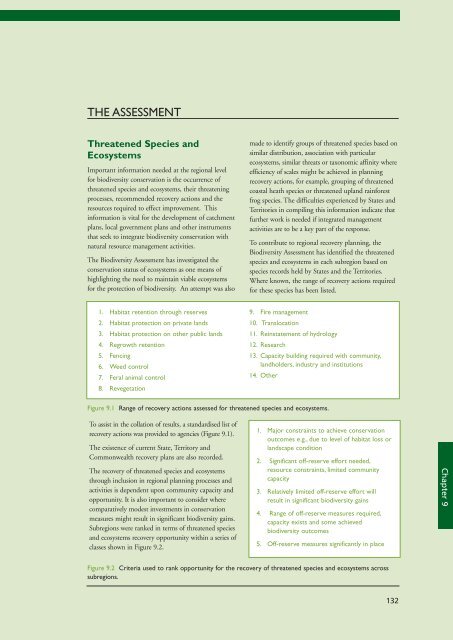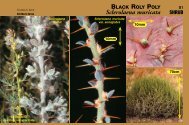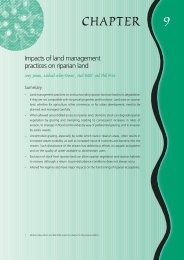australian terrestrial biodiversity assessment 2002 - Land and Water ...
australian terrestrial biodiversity assessment 2002 - Land and Water ...
australian terrestrial biodiversity assessment 2002 - Land and Water ...
Create successful ePaper yourself
Turn your PDF publications into a flip-book with our unique Google optimized e-Paper software.
THE ASSESSMENT<br />
Threatened Species <strong>and</strong><br />
Ecosystems<br />
Important information needed at the regional level<br />
for <strong>biodiversity</strong> conservation is the occurrence of<br />
threatened species <strong>and</strong> ecosystems, their threatening<br />
processes, recommended recovery actions <strong>and</strong> the<br />
resources required to effect improvement. This<br />
information is vital for the development of catchment<br />
plans, local government plans <strong>and</strong> other instruments<br />
that seek to integrate <strong>biodiversity</strong> conservation with<br />
natural resource management activities.<br />
The Biodiversity Assessment has investigated the<br />
conservation status of ecosystems as one means of<br />
highlighting the need to maintain viable ecosystems<br />
for the protection of <strong>biodiversity</strong>. An attempt was also<br />
1. Habitat retention through reserves<br />
2. Habitat protection on private l<strong>and</strong>s<br />
3. Habitat protection on other public l<strong>and</strong>s<br />
4. Regrowth retention<br />
5. Fencing<br />
6. Weed control<br />
7. Feral animal control<br />
8. Revegetation<br />
To assist in the collation of results, a st<strong>and</strong>ardised list of<br />
recovery actions was provided to agencies (Figure 9.1).<br />
The existence of current State, Territory <strong>and</strong><br />
Commonwealth recovery plans are also recorded.<br />
The recovery of threatened species <strong>and</strong> ecosystems<br />
through inclusion in regional planning processes <strong>and</strong><br />
activities is dependent upon community capacity <strong>and</strong><br />
opportunity. It is also important to consider where<br />
comparatively modest investments in conservation<br />
measures might result in significant <strong>biodiversity</strong> gains.<br />
Subregions were ranked in terms of threatened species<br />
<strong>and</strong> ecosystems recovery opportunity within a series of<br />
classes shown in Figure 9.2.<br />
made to identify groups of threatened species based on<br />
similar distribution, association with particular<br />
ecosystems, similar threats or taxonomic affinity where<br />
efficiency of scales might be achieved in planning<br />
recovery actions, for example, grouping of threatened<br />
coastal heath species or threatened upl<strong>and</strong> rainforest<br />
frog species. The difficulties experienced by States <strong>and</strong><br />
Territories in compiling this information indicate that<br />
further work is needed if integrated management<br />
activities are to be a key part of the response.<br />
To contribute to regional recovery planning, the<br />
Biodiversity Assessment has identified the threatened<br />
species <strong>and</strong> ecosystems in each subregion based on<br />
species records held by States <strong>and</strong> the Territories.<br />
Where known, the range of recovery actions required<br />
for these species has been listed.<br />
9. Fire management<br />
10. Translocation<br />
11. Reinstatement of hydrology<br />
12. Research<br />
13. Capacity building required with community,<br />
l<strong>and</strong>holders, industry <strong>and</strong> institutions<br />
14. Other<br />
Figure 9.1 Range of recovery actions assessed for threatened species <strong>and</strong> ecosystems.<br />
1. Major constraints to achieve conservation<br />
outcomes e.g., due to level of habitat loss or<br />
l<strong>and</strong>scape condition<br />
2. Significant off-reserve effort needed,<br />
resource constraints, limited community<br />
capacity<br />
3. Relatively limited off-reserve effort will<br />
result in significant <strong>biodiversity</strong> gains<br />
4. Range of off-reserve measures required,<br />
capacity exists <strong>and</strong> some achieved<br />
<strong>biodiversity</strong> outcomes<br />
5. Off-reserve measures significantly in place<br />
Figure 9.2 Criteria used to rank opportunity for the recovery of threatened species <strong>and</strong> ecosystems across<br />
subregions.<br />
132<br />
Chapter 9




